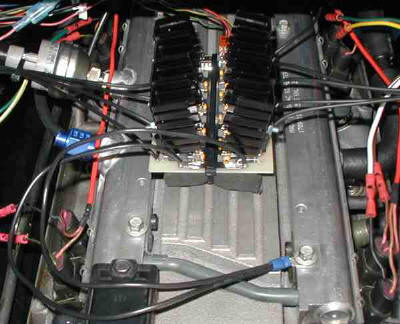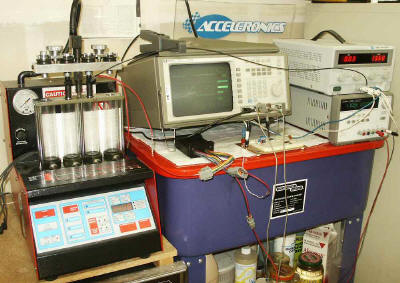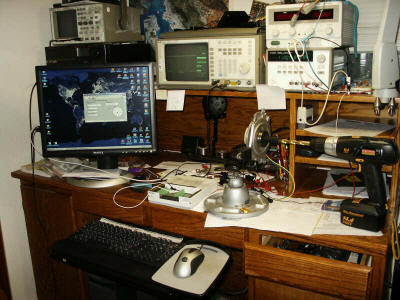What is Acceleronics?
| Acceleronics is a company that resulted from two significant factors in my life; a deep-rooted fascination with fast cars, and two University degrees in electronics engineering. Click here to visit the Acceleronics web site. |
Coaxing more horsepower from your fuel injected engine
|
Automobile engines have used electronic fuel injection to feed gasoline to the engine for decades. One of the fundamental factors limiting the maximum power an engine can produce is the size of its fuel injectors. More power requires more gasoline, and more gasoline means larger fuel injectors. But it's not quite that simple... Today's fuel injectors fall into two broad categories distinguished by the electrical impedance of their coils (think of a donut made by winding a piece of wire around and around in a circle). The coil is the electric "motor" that opens and closes a valve that controls the flow of gasoline through the injector. That is, when electricity is flowing through a fuel injector's coil wire, the resulting magnetic force opens a valve that enables gasoline to flow through the injector. When electricity stops flowing through the coil wire, the gasoline valve closes. The amount of electricity that can flow through a fuel injector's coil winding is determined by the coil's impedance. Impedance is a bit tricky to understand, but you can get a feel for what's going on by comparing impedance to drinking a milk shake through a straw. High impedance is like a small straw - you don't get much milk shake for all your effort. Similarly, not much electricity flows through a high impedance fuel injector coil when the injector is on. Low impedance is like a big straw - you get a lot more milk shake into your mouth with the same amount of suck. As you can probably guess, much more electricity flows through a low impedance fuel injector. This difference in the amount of electricity flowing through the coil is the key difference between high impedance and low impedance injectors. |
The magnetic force generated by a coil of wire is proportional to the amount of electricity flowing through the coil wire. More electricity means more force. In terms of fuel injectors, low impedance results in more electricity flowing through the coil, and that, in turn, generates a more powerful magnetic force. Finally, more force leads to the ability to open a larger gasoline valve. Putting all of this together, high impedance fuel injectors have relatively low gasoline flow limits because not very much electricity flows through the coil. Low impedance injectors, on the other hand, can be relatively huge because so much electricity flows through the coil. If you want to build an engine with a LOT of horsepower, you have to use low impedance injectors. But there is a catch! Fuel injectors are operated by a computer sometimes called the ECU, for engine control unit. The ECU that comes installed in all cars I'm aware of can only drive high impedance injectors. Low impedance injectors use so much electricity that that they will fry the ECU, turning it into a not-very-attractive doorstop. Aftermarket ECUs are available that can operate low impedance injectors, but they generally cost $2000 or more (much more in some cases). I reached this point of frustration in 2001. My engine had the largest high impedance fuel injectors I could find, but they weren't big enough for what I had in mind. The original ECU was doing a good job of running the engine, so I didn't want to spend big bucks on a new one simply so that I could use low impedance injectors. The solution was to apply my electronic design knowledge to the creation of a device that would let me run low impedance injectors and also retain the original ECU. |
Birth of the VersaFueler
|
Other than circuit board soldering, cable and final product assembly, and CNC machining of the heat sink, I do all Acceleronics tasks myself. These include:
The two thumbnail pictures below show my fuel injector flow test equipment (left) and electronic design work bench (right). Click on them for a better view. |


